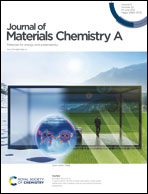Electrical resistance change in thermally reconfigured nanoporous ionomer-bound carbon films†
Abstract
The electrical resistance of nanoporous ionomer-bound carbon films is critical for the performance of future devices that utilize these films. However, the thermally self-changed electrical characteristics remain concealed, although the films are exposed to various temperatures during their fabrication and operation. Here, we present the self-changed characteristics and reveal their nanostructural origin. The thermal transitions of the few-nanometer ionomer binder cause the structural reconfiguration of the charge conductors. These thermomechanical behaviors allow for optimal continuities in the ionic and electronic conductors, the nano-networking of which becomes highly self-enhanced as the reconfiguration temperature increases. The thermal kinetics of nanoporous films are investigated using differential scanning calorimetry, and the characterization indicates that the nanostructural alterations of the conductors originate from the crystallized packing and melt flow of the ionomer binder. Such thermal behavior causes the initially disconnected ionomer-bound carbon agglomerates to be bridged, which is visually examined using a scanning transmission electron microscope. Electrochemical impedance spectroscopy measures ∼40% enhancements in ionic and electronic resistances owing to the higher degree of nano-networking in the conductors. Above the second transition temperature, the nanoporous films demonstrate electronic degradation as the ionomer penetrates into the niche spaces between carbon particles, resulting in electron path insulation.



 Please wait while we load your content...
Please wait while we load your content...